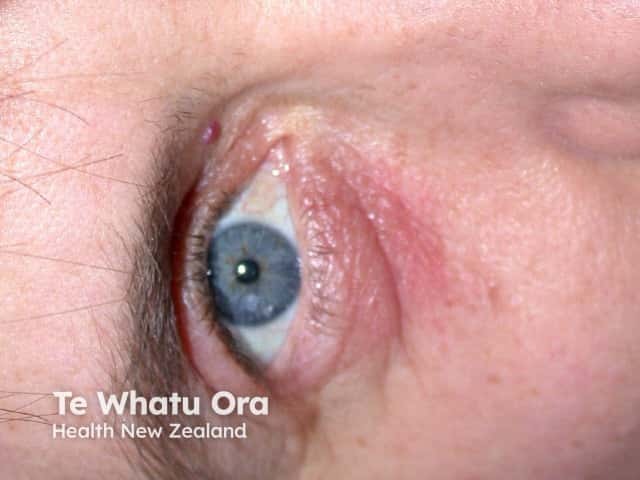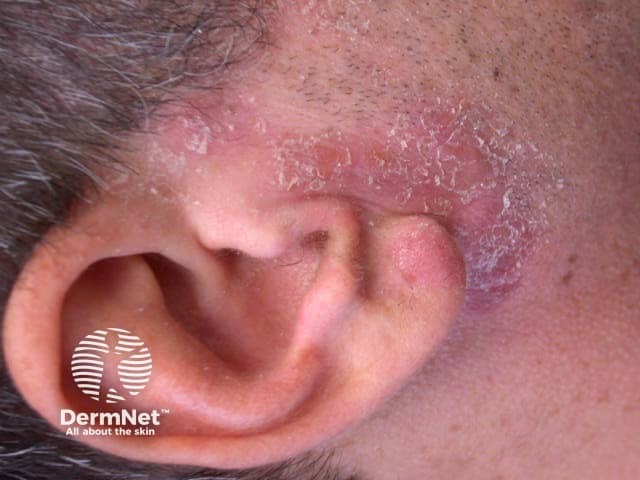Main menu
Common skin conditions

NEWS
Join DermNet PRO
Read more
Quick links
Airborne contact dermatitis — extra information
Airborne contact dermatitis
Authors: Dr Sarajane Ting, General Practitioner, Wellington, New Zealand; A/Prof Rosemary Nixon, Dermatologist, Melbourne, Australia. Adjunct A/Prof Dr Amanda Oakley, Dermatologist, Hamilton, New Zealand. Copy edited by Gus Mitchell/Maria McGivern. September 2019.
Introduction Classification Demographics Causes Clinical features Diagnosis Differential diagnoses Treatment Outcome
What is airborne contact dermatitis?
Airborne contact dermatitis refers to acute and chronic dermatitis of exposed parts of the body, especially the face, caused by particles suspended in the air. These particles may include fibres, dust, vapours, sprays, gases, and plant materials.
Contact dermatitis is defined as airborne based on the following factors:
- The existence of a volatile or airborne causative agent
- The clinical presentation
- The history of the patient
- Patch testing.

Airborne contact dermatitis eyelid

Airborne dermatitis due to epoxy allergy

Airborne contact dermatitis due to plant pollen
How is airborne contact dermatitis classified?
Airborne contact dermatitis includes:
- Airborne irritant contact dermatitis
- Airborne allergic contact dermatitis
- Airborne phototoxic dermatitis (see DermNet's page on Photocontact dermatitis)
- Airborne photoallergic dermatitis.
Apart from resulting in dermatitis, airborne skin disease can also present as:
- Airborne contact urticaria
- An acneiform reaction
- A lichenoid eruption
- Exfoliative dermatitis
- Lymphomatoid contact dermatitis
- Purpura
- A pustular reaction
- Telangiectasia
- An erythema multiforme-like reaction.
Who gets airborne contact dermatitis?
Airborne contact dermatitis can affect anyone; it is seen commonly in occupations associated with exposure to known allergens (see DermNet's page on occupational skin disease).
Workers in the following industries are commonly affected:
- Painting and paint manufacture
- Hairdressing
- Beauty industry
- Construction and building
- The surface coatings industry
- Furniture manufacture, the timber industry, and carpentry
- Pharmaceuticals, pharmacy, and healthcare
- Agriculture.
A personal history of atopy, particularly atopic dermatitis, is also a risk factor for airborne allergic and irritant contact dermatitis.
What causes airborne contact dermatitis?
The sources of airborne contact dermatitis may be occupational or non-occupational. Some common causal agents of airborne contact dermatitis are listed below.
Airborne allergic contact dermatitis
Airborne allergens that can induce allergic contact dermatitis include:
- Preservatives — particularly methylisothiazolinone, formaldehyde, and benzalkonium chloride — there has been a recent epidemic of airborne allergic contact dermatitis from methylisothiazolinone in water-based paints on freshly painted walls
- Paraphenylenediamine in hair dye and ammonium persulfate (hairdressing bleach)
- Plastic, rubber, and glue components — including epoxy resin, phenol-formaldehyde resin, acrylate, isocyanate, and thiuram
- Plants, natural resins, and wood allergens — including Parthenium hysterophorus, Compositae, rosin from pine, propolis, tropical woods, Tanacetum parthenium (feverfew); Parthenium dermatitis is widespread in India
- Drugs — budesonide, omeprazole, olanzapine, tetrazepam, and statins
- Metals — particularly gold, mercury, and nickel.
Airborne irritant contact dermatitis
Airborne irritants that induce irritant contact dermatitis include:
- Fibreglass
- Chlorothalonil
- Continuous positive airway pressure (CPAP) filtered air; this can cause airborne irritant contact blepharitis.
Photoallergic reactions
Photoallergic reactions that can induce airborne contact dermatitis include:
- Drug photoallergy — chlorpromazine and carprofen
- Olaquindox (veterinary use)
- Pesticides.
Contact urticaria
Airborne allergens that can induce contact urticaria may include:
- Latex
- Amoxicillin
- Epoxy resin
- Ammonium persulfate (hairdressing bleach)
- Pine processionary caterpillar (Thaumetopoea pityocampa).
What are the clinical features of airborne contact dermatitis?
The distribution of airborne contact dermatitis is usually symmetrical. The exposed areas are most commonly affected, including the face, dorsal hands, neck, upper chest, and forearms. Eyelid contact dermatitis is common and can be the only affected site. Occasionally, covered areas can also be affected due to the accumulation of airborne particles under the garments.
Common symptoms of airborne contact dermatitis include itching, burning, and stinging.
Airborne contact dermatitis usually presents with diffuse scaly erythematous macules but plaques may also occur. Sometimes a pustular rash can occur as a result of secondary bacterial infection.
How is airborne contact dermatitis diagnosed?
The diagnosis of airborne contact dermatitis can be difficult. The diagnosis relies on taking a comprehensive clinical history, the timeline of the symptoms, consideration of occupational and non-occupational exposures, and finding the characteristic distribution and morphology of the rash on physical examination.
Tests that can be considered are:
What is the differential diagnosis for airborne contact dermatitis?
Airborne contact dermatitis should be distinguished from the following conditions:
- Non-airborne irritant contact dermatitis and allergic contact dermatitis
- Non-airborne photocontact dermatitis — in contrast to airborne contact dermatitis, non-airborne photodermatitis spares ‘shadow’ areas such as the eyelids, retroauricular folds, and submental regions (the muscles between the chin and the neck)
- Systemic contact dermatitis
- Ectopic contact dermatitis
- Atopic dermatitis
- Seborrhoeic dermatitis, especially when the patient is photosensitive.
What is the treatment for airborne contact dermatitis?
The treatment for airborne contact dermatitis depends on the specific cause. After identifying the specific substance causing airborne contact dermatitis, every effort should be made to reduce the exposure to it. A change of job or residence is sometimes necessary to reduce exposure.
Other measures include:
For severe cases, treatment can include:
What is the outcome for airborne contact dermatitis?
Airborne contact dermatitis can have a significant impact on patients’ quality of life. Complete recovery can often be achieved with avoidance of further exposure, but in severe cases such as Parthenium dermatitis, immunosuppression is often required. Some patients may progress to chronic actinic dermatitis.
References
- Pongpairoj K, Ale I, Andersen KE, et al. Proposed ICDRG classification of the clinical presentation of contact allergy. Dermatitis 2016; 27: 248–58. DOI: 10.1097/DER.0000000000000222. PubMed
- Lotti T, Menchini G, Teofoli P. The challenge of airborne dermatitis. Clin Dermatol 1998; 16: 27–31. DOI: 10.1016/s0738-081x(97)00168-5. PubMed
- Lachapelle JM. Environmental airborne contact dermatoses. Rev Environ Health 2014; 29: 221–31. DOI: 10.1515/reveh-2014-0054. PubMed
- Goossens A. Airborne dermatosis. Acta Dermatovenerol Croat 2006; 14: 153–5. PubMed
- Cashman MW, Reutemann PA, Ehrlich A. Contact dermatitis in the United States: epidemiology, economic impact and workplace prevention. Dermatol Clin 2012; 30: 87–98. DOI: 10.1016/j.det.2011.08.004. PubMed
- Swinnen I, Goossens A. An update on airborne contact dermatitis: 2007–2011. Contact Dermatitis 2013; 68: 232–8. DOI: 10.1111/j.1600-0536.2007.01233.x. PubMed
- Santos R, Goossens A. An update on airborne contact dermatitis: 2001–2006. Contact Dermatitis 2007; 57: 353–60. DOI: 10.1111/j.1600-0536.2007.01233.x. PubMed
- Huygens S, Goossens A. An update on airborne contact dermatitis. Contact Dermatitis 2001; 44: 1–6. DOI: 10.1034/j.1600-0536.2001.440101.x. PubMed
- Wright AM, Cahill JL. Airborne exposure to methylisothiazolinone in paint causing allergic contact dermatitis: an Australian perspective. Australas J Dermatol 2016; 57: 294–5. DOI: 10.1111/ajd.12384. PubMed
- Lundov MD, Zachariae C, Menné T, Johansen JD. Airborne exposure to preservative methylisothiazolinone causes severe allergic reactions. BMJ 2012; 345: e8221. DOI: 10.1136/bmj.e8221. PubMed
- Lundov MD, Mosbech H, Thyssen JP, Menné T, Zachariae C. Two cases of airborne contact dermatitis caused by methylisothiazolinone in wall paint. Contact Dermatitis 2011: 65: 176–9. DOI: 10.1111/j.1600-0536.2011.01924.x. PubMed
- Alwan W, White IR, Banerjee P. Presumed airborne contact allergy to methylisothiazolinone causing acute severe facial dermatitis and respiratory difficulty. Contact Dermatitis 2014: 70: 320–1. DOI: 10.1111/cod.12219. PubMed
- Sanjeev H, Dipankar D, Mahajan R. Airborne contact dermatitis — current perspectives in etiopathogenesis and management. Indian J Dermatol 2011; 56: 700–6. DOI: 10.4103/0019-5154.91832. PubMed Central
- Lachapelle JM. Industrial airborne irritant or allergic contact dermatitis. Contact Dermatitis 1986; 14: 137–45. DOI: 10.1111/j.1600-0536.1986.tb01193.x. PubMed
- Schloemer JA, Zirwas MJ, Burkhart CG. Airborne contact dermatitis: common causes in the USA. Int J Dermatol 2015; 54: 271–4. DOI: 10.1111/ijd.12692. PubMed
- Sharma VK, Sethuraman G. Parthenium dermatitis. Dermatitis 2007; 18: 183–90. DOI: 10.2310/6620.2007.06003. PubMed
On DermNet
Other websites
- Contact dermatitis: Diagnosis & Treatment — American Academy of Dermatology
- Allergic contact dermatitis — Medscape
- Contact dermatitis — MedlinePlus
